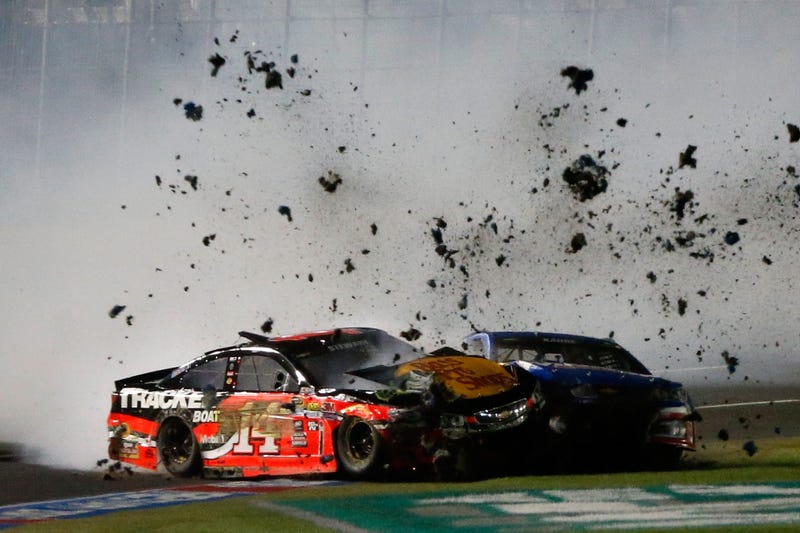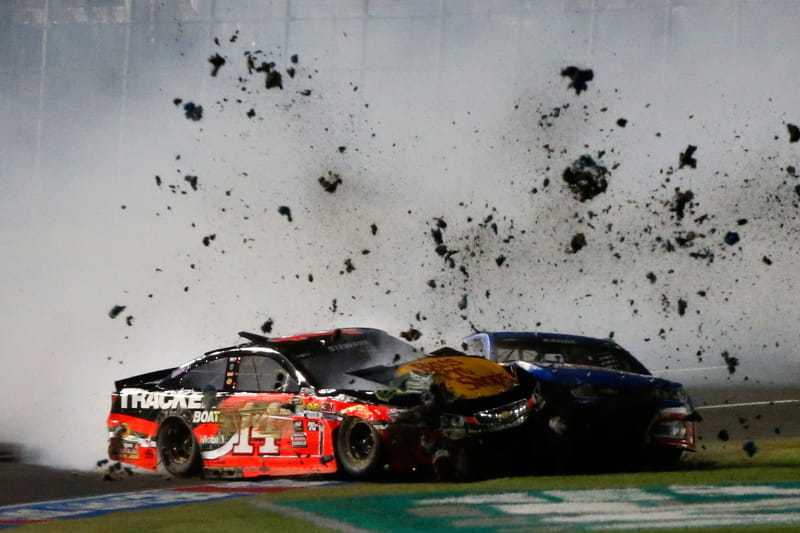
The “All-Star” event in any sport is a special one, since the best competitors get to battle it out with not much at stake but their pride. NASCAR has one also, and they try to make the race unique by using a new, oddball format each year. This year was so bad, though, that not even competitors knew what was going on.
For those who didn’t watch the race—perhaps because you read the race format first and decided, “Nope, not today”—the actual on-track product at Charlotte Motor Speedway was good. There were relentless battles for position despite the fact that only the winner gets the $1 million prize, and the overall competition made for quality racing.
The problem came with the format, which backfired so badly that there’s not really a metaphor for it. The most common phrase of the evening was a variant of “Why are we doing this?” or “We don’t know.” Tony Stewart even went on an angry rant after wrecking out of the event, saying it was “the most screwed up All-Star Race” he’d ever participated in and that he was glad it was his last one. Other drivers mirrored that opinion on Twitter following the race.
Advertisement
Before we get into the dumpster fire that caused all of the confusion, let’s make sure we all understand the format. Here it is, per NASCAR.com:
THE RULES, SEGMENT 1
The lineup for Segment 1 is determined by qualifying run earlier Saturday night. [Author’s note: there was no qualifying due to rain.]
There is a mandatory green-flag pit stop for a minimum of two tires (teams can choose to take two or four) during the opening 50 laps.
After Segment 1, there is a 3-5 minute break. Cars must pit and take a minimum of two tires.
THE RULES, SEGMENT 2
The starting order for Segment 2 is set by the pit-road exit from the mandatory pit stop after Segment 1.
During Segment 2, there is a mandatory green-flag pit stop for a minimum of two tires during this set of 50 laps. The twist here is that the pit stop must occur before Lap 85.
After Segment 2 concludes, there is another 3-5 minute break.
THE RULES, SEGMENT 3
During the break between Segments 2 and 3, there is a random drawing in which the number 9, 10 or 11 is selected. That number determines the number of cars from the 20-car field (starting from whoever is leading the race) which must pit for a mandatory four-tire stop. Pit road is closed to the additional cars.
Those who did not pit will be on older tires and at the front of the field. The order off pit road sets the running order behind those cars. So it will be older tires at the front and fresher tires (and likely faster cars) at the rear. Plenty of strategy to be had.
Only green-flag laps count in Segment 3, and NASCAR Overtime procedures apply.
The problems started in the first segment, when a caution came out near the end of the 50 laps. The No. 20 car of Matt Kenseth had yet to make his pit stop and sat in the lead, leaving about half of the field one lap down. Due to the pit-stop rules after each segment, NASCAR’s regular wave-around rule couldn’t apply at the ends of the segments to get those unintentionally trapped drivers back on the lead lap.
Sponsored
Having so many cars one lap down made the procedures for the final segment—an inversion method that somewhat mirrors what short-track and Late Model races do on occasion —made for the opposite of what it looks like the format aimed for. Only Jimmie Johnson and Kyle Busch sat in the lead-lap positions that didn’t qualify for the four-tire pit stop, making for two drivers getting run over on older tires rather than a cushier set of 10 or so—which, judging by the restart that began segment three, easily could have started a large pileup.
To be fair, NASCAR Senior VP of Competition Scott Miller told reporters after the race that “it was a very unique situation and [NASCAR] did not in [its] race procedures have a mechanism to correct that.” The move by Kenseth’s team—which wasn’t necessarily wrong, just too late—he said, “hurt the whole race.”
Officials also pulled drivers down pit road for mandatory checks of lug-nut tightness throughout the race, which threw drivers off and led to odd breaks in the action. A violation led to an in-race penalty, and Carl Edwards had to serve one by heading to the tail end of the field.
In the end, drivers, competitors, viewers and even commentators on occasion were perplexed in trying to figure out the proceedings of the race. As for the lack of a wave-around opportunity that essentially sunk the workability of the event, Miller said it’s something that if NASCAR “continues on with this format, [they] have to look at.”
Advertisement
Of course, talking about this year’s format is futile. With the amount of changes it goes through each year, we’ll be watching a completely different race come 2017. What the event needs is a true overhaul that far surpasses breaking up 100 laps differently each year and adding strange plot twists along the way, but that is a far-fetched thing to hope for.
Until something changes, NASCAR’s All-Star Race will be doomed to a fate of wonky formats. It takes place on a 1.5-mile “cookie cutter” oval, the type of race track that has a large presence on the NASCAR schedule and in its 10-race Chase for the Sprint Cup championship playoff. There’s nothing truly unique about the track—other than its location in NASCAR central, Charlotte, North Carolina—so series needs aspects to set it apart from the other events.
A move to Charlotte Motor Speedway’s dirt track has been proposed, but that’s a long shot. Only one of NASCAR’s top-three national series currently goes to a venue with a dirt racing surface, and the Camping World Truck Series’ annual stop at Eldora Speedway only started back in 2013.
Adding dirt to the mix isn’t likely to happen, as can be assumed by how slim the population of dirt racing is on the NASCAR national schedule in the first place. We’re likely all stuck with a non-constant format that will have its years of trial and error—mostly error, if history can be trusted.
No matter the format, the goal should be to keep it simple. It shouldn’t be a math equation that competitors, participants and viewers would need to keep a journal for in order to be able to follow.
But even if we’re all confused about what exactly is going on, the quality of racing from Saturday night is, at least, a positive sign for the future.













